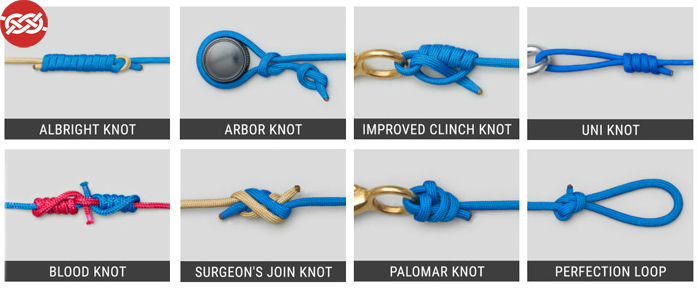8 Fishing Knots You Absolutely Must Know Part 2
In our first article, we covered fishing knots that are used for joining lines together or attaching lines to spools. In this article, there are 4 other fishing knots that every angler should know. These knots are used for attaching a line to fishing hooks and lures. If you aren’t using these techniques now is the time to learn.
Let’s jump in and explore the Uni, Perfection, Improved Clinch, and Palomar fishing knots. These knots will help you secure your lures on your next adventure.
UNI KNOT
The Uni Knot, or “The Only knot you need to know,” goes by many names. It was invented by Norman Duncan so it is also known as the Duncan Knot by some. If you use it to join two different lines then it is known as the Double Uni Knot.
The Uni Knot works well with braided lines and monofilament fishing lines alike. The great thing about the uni knot is that the strength of the knot is not compromised when a fish jerks the line rather than pulls. Testing of the knot strength has shown 82% – 90% of the line strength. If you have a large fish surging the line then your break percentage could be as high as 60%.
The simplicity of the uni knot means that you can learn it quickly and tie it in low visibility easily. Whether you use it for your fishing hook or reels the uni knot will serve you well. If you want to see a step by step you can find it on Animated Knots.
PERFECTION LOOP
The Perfection Loop Knot is also known as the Angler’s Loop in The Ashley Book of Knots. This versatile knot is one of the easiest knots for fly fishers to make a small loop at the end of a leader or tippet that will lie perfectly in line with the standing end. You can use a “Loop to Loop” connection to join two perfection knots such as the end of the fly line with the leader. This method allows for quick leader changes.
Additionally, you can use the perfection knot for small fishing hooks and lures on fluorocarbon leaders and connected back to the fly line. The use of this knot gives you an easy way to attach a streamer to your tippet. The beauty of the perfection knot is that it allows for more movement of the streamer and makes the fly more lifelike.
If you need further instruction you can see the steps on Animated Knots.
IMPROVED CLINCH KNOT
The Improved Clinch Knot is another one of the most common and widely used fishing knots for anglers. A timeless method for securing a fishing line to fishing hooks, lures, or swivel. Shown above and in the video is the “improved” version that has few extra steps. The most common use of the clinch knot is for attaching the leader to the fly. Be warned though, it is difficult to tie on lines that are over 25 pounds breaking strength. It is also not a good idea for braided lines.
Anglers have used the Improved Clinch Knot as a go-to for attaching a small diameter tippet to a heavy wire hook. The “improved” bit is the extra final tuck at the end, this vastly improves your chances of holding a strong fish. Again if you need a step by step then check out Animated Knots.
PALOMAR KNOT
Lastly, we have the Palomar Knot that is a very simple way to attach a line to a hook or a fly to a leader or tippet. This knot is best for braided lines and is one of the strongest fishing knots.
This knot is almost 100% knot if you tie it correctly; however, if you tie it incorrectly it will fail. With practice, you can easily tie the knot, even in the dark. Something to keep in mind is the hook or fly has to pass through the loop, so make the loop larger for this reason. Check out the video or the step by step on Animated Knots.
That concludes our two-part series on fishing knots that every angler should know. If you missed out on part 1 then you can read up on it and learn the essential fishing knots for attaching lines to reels and tying lines together.
I grew up in Canada, but unfortunately, I did not take advantage of shooting or hunting when I lived there. I just didn’t grow up with it, but I did fish a lot. It’s only after I joined a firearm company that I could reap the benefits of having great mentors teach me the ropes. Now I’m hooked and want to experience everything I can! So much so, I was compelled to co-found this site. I hope you enjoy it, and all feedback is welcome.





